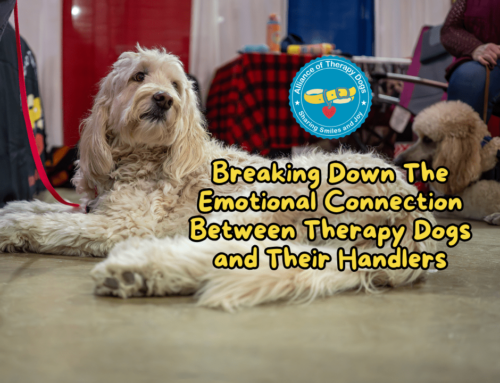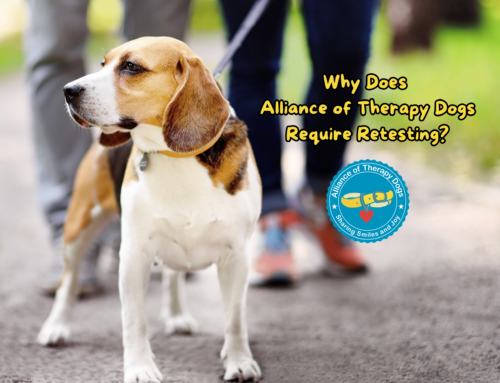The Alliance of Therapy Dogs, the premier therapeutic dog organization, witnessed (as did you) the terrific flooding in Texas. Thousands of Texans were left homeless as they waded through the waters to find shelter. Hurricane Harvey was a reminder that every family should have a disaster preparedness plan that should include your pet(s). In this article, we will discuss the need for a disaster preparedness plan and preparedness kit for your pets and the ways in which you can avoid injury or illness after caring for your pets in a natural disaster.
How Do I Make a Disaster Plan and Preparedness Kit for My Pets?
Leaving pets out of evacuation plans can put pets, pet owners, and first responders in danger. Even if you try to create a safe place for them, pets left behind during a natural disaster are likely to be injured, lost, or worse. It is your responsibility as a pet owner to find out what type of shelters and assistance are available in your area to accommodate pets and to include pets in your disaster plan to keep them safe during an emergency.
Expect the unexpected, make a plan and prepare a disaster kit for your family and pet(s).
According to the Center for Disease Control, steps towards pet disaster preparedness for your pet(s) should include:
- Make sure your pet(s) wear collars and tags with up-to-date contact information and other identification.
- Microchip your pet(s) – this is one of the best ways to ensure that you and your pet are reunited if you are separated. Always be sure to register the microchip with the manufacturer and keep your contact information up to date with the microchip company.
- Purchase a pet carrier for each of your pets and write your pet’s name, your name and contact information on each carrier.
- Familiarize your pet with its transport crate before a crisis.
- Practice transporting your pet by taking them in their carriers for rides in a vehicle similar to the one you would be evacuating in.
- Practice catching your pet, if needed.
- Keep a leash and/or carrier nearby the exit.
- Ensure proper equipment for pets to ride in the car such as carriers, harnesses, pet seatbelts.
- If you do not have a car, make arrangements with neighbors, family, and friends. You can also contact your local government to learn about transportation options during a disaster.
Decide where you and your pet are going to stay. Based on the severity of a disaster, you may have two options for your pets:
- Sheltering in place
- Sheltering in a facility away from home
Sheltering in place
When sheltering your pet(s) at home, make sure the room chosen is pet-friendly in the following ways:
- Select a safe room, preferably an interior room with no or few windows.
- Remove any toxic chemicals or plants.
- Close off small areas where frightened pets could get stuck such as air vents or beneath heavy furniture.
Sheltering during an evacuation
Contact your local emergency management office and ask if they offer accommodations for owners and their pets. If accommodations are needed for your pet(s), contact local veterinary clinics, boarding facilities, and local animal shelters. It is also advisable to visit the Humane Society website to find a shelter in your area.
Contact family or friends outside the evacuation area.
Contact a pet-friendly hotel, particularly along evacuation routes.
Make plans before disaster strikes for where you and your pets will find shelter. Be aware that pets may not be allowed in local human shelters unless they are service animals.
Should you be able to evacuate the area, pet-friendly accommodations can be found throughout the United States.
- www.bringfido.com or call 877-411-FIDO
- www.dogfriendly.com or call 888-281-5170
- www.doginmysuitcase.com or call 8880254-0637
- www.pet-friendly-hotels.net or call 866-966-3046
- www.pets-allowed-hotels.com or call 800-250-1625
- www.petswelcome.com or call 845-297-5150
- www.tripswithpets.com or call 866-212-1803
What Items Should be Included in a Disaster Preparedness Kit for my Pet?
The Center for Disease Control offers a disaster checklist for pets. To download, please click here.
Disaster Supplies for Pets
- Food in airtight waterproof containers or cans and water for at least 2 weeks for each pet
- Medications for at least 2 weeks, along with any treats used to give the medications and pharmacy contact for refills
- Food and water bowls and a manual can opener
- For cats: litter box and litter
- For dogs: plastic bags for poop
- Clean-up items for bathroom accidents – paper towels, plastic trash bags, bleach-containing cleaning agent
- Sturdy leashes or harnesses
- Carrier or cage that is large enough for your pet to stand comfortably and turn around
- Towels or blankets
- Pet toys and bed – familiar items to help the pet[s] feel more comfortable
- A handout containing identification information should you get separated from your pet
- A handout with boarding instructions, such as feeding schedule, medications, and any known allergies and behavior problems
- Documents, medications, and food should be stored in waterproof containers
Medical records
- Rabies vaccination certificate
- Current vaccination record
- If your pet has a microchip, a record of the microchip number
- Prescription for medication(s)
- For cats, most recent FeLV/FIV test result or vaccination date
- Summary of pertinent medical history; ask your veterinarian for a copy
How Can I Protect Myself from Injury and Illness After Caring for My Pet During a Natural Disaster?
Disasters are stressful for humans and pets alike. Practice safe handling of your pet, as your pet may behave differently during a stressful situation.
To avoid common diseases that pets can transmit to people,
- Wash your hands before and after handling your pet and its waste.
- Wash your hands after handling pet food or treats.
- Wash your hands after picking up your pet’s stool or cleaning a litter box.
- Avoid letting your pet lick your face or hands.
The Alliance of Therapy Dogs knows that a pet is a lot more than just a “pet.” Leaving a pet behind in a disaster is akin to leaving a family member. A disaster preparedness plan and kit for pets should be in every home and easily accessible. To learn more about disaster preparedness for your pet, please contact the Alliance of Therapy Dogs.







I have been searching all over a post about that for quite a long time. Thanks for publishing this great content without doubts is very useful. I absolutely love your blog. Excellent colors
Im glad that you shared this useful info with us. Please stay us informed like this. Thank you for sharing. live tv
yes I actually learned it too
Hello thank you very much
Great information, absolutely beautiful.
Great information, absolutely beautiful.
Great information, absolutely beautiful.